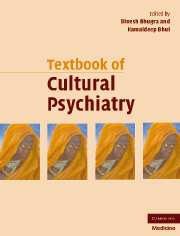Book contents
- Frontmatter
- Contents
- Contributors
- Foreword
- Preface
- Part I Theoretical background
- Part II Culture and mental health
- Part III Culture and mental disorders
- 15 Neurosis
- 16 Schizophrenia and related psychoses
- 17 Affective disorders
- 18 Substance misuse
- 19 Culture and mental disorders: suicidal behaviour
- 20 Personality disorders and culture
- 21 Culture and obsessive-compulsive disorder
- 22 Culture and eating disorders
- 23 Childhood and adolescent psychiatric disorders
- 24 Culture and schizophrenia
- 25 Disorders of ageing across cultures
- Part IV Theoretical aspects of management
- Part V Management with special groups
- Part VI Cultural research and training
- Cultural psychiatry: the past and the future
- Index
- References
25 - Disorders of ageing across cultures
from Part III - Culture and mental disorders
Published online by Cambridge University Press: 11 August 2009
- Frontmatter
- Contents
- Contributors
- Foreword
- Preface
- Part I Theoretical background
- Part II Culture and mental health
- Part III Culture and mental disorders
- 15 Neurosis
- 16 Schizophrenia and related psychoses
- 17 Affective disorders
- 18 Substance misuse
- 19 Culture and mental disorders: suicidal behaviour
- 20 Personality disorders and culture
- 21 Culture and obsessive-compulsive disorder
- 22 Culture and eating disorders
- 23 Childhood and adolescent psychiatric disorders
- 24 Culture and schizophrenia
- 25 Disorders of ageing across cultures
- Part IV Theoretical aspects of management
- Part V Management with special groups
- Part VI Cultural research and training
- Cultural psychiatry: the past and the future
- Index
- References
Summary
EDITORS' INTRODUCTION
Human beings age but the response to age, ageing and the aged is very strongly influenced by cultures. In some cultures 80-year-old males or females marrying partners younger than them barely raise an eyebrow. However, in others, once an individual has reached the age of 60, celebrations to mark the occasion include ‘remarrying’ their spouse. The respect offered to the aged is dictated by cultural values and social roles. The longevity of individuals varies across cultures consequent to a number of factors including genetic, physical, dietary and other environmental factors. The response to ageing is largely social and cultural, from involving the aged in familial decisions to placing them out of sight in nursing homes. With an increase in longevity, the population of elderly is also becoming larger in many cultures.
Shah and MacKenzie provide not only background information on international and some national demographic changes, but they also illustrate cultural differences in epidemiological findings and related social factors. Use of cognitive tests (developed in Western countries) in individuals from low-income countries, rural areas, different concepts of orientation in time and place in different cultures and preferential use of the Western or traditional calendar all play a role in confounding the diagnosis of conditions such as dementia. The expression of depression across different cultures and also differing vocabulary and language to express emotions and feelings influence the way in which diagnosis can be influenced. Shah and MacKenzie use examples of existing diagnostic instruments to illustrate problems of category fallacy.
- Type
- Chapter
- Information
- Textbook of Cultural Psychiatry , pp. 323 - 344Publisher: Cambridge University PressPrint publication year: 2007
References
- 19
- Cited by



